Share On Social!
This is part of the Salud America! The State of Latinos and Housing, Transportation, and Green Space: A Research Review »
Summary
An increasing number of Latinos are burdened by high housing costs and can even face possible eviction, displacing them from urban centers near public transport to the fringes of urban areas, where transport, services, and employment are more difficult to access.
Housing Affects Health
Currently at 58.6 million, Latinos account for more U.S. population growth than any other demographic [1]. Public policy has led to decades of disinvestment in low-income communities and communities of color in the United States, which has led to worsened physical and mental health in these communities [16, 17].
Health equity refers to the ability of all individuals to reach their full health potential [5], and several studies have shown that inequities in health actually arise from social and structural inequities, including poverty, racism, segregation, and the policies, laws, and culture that keep them in place [5, 6, 16].
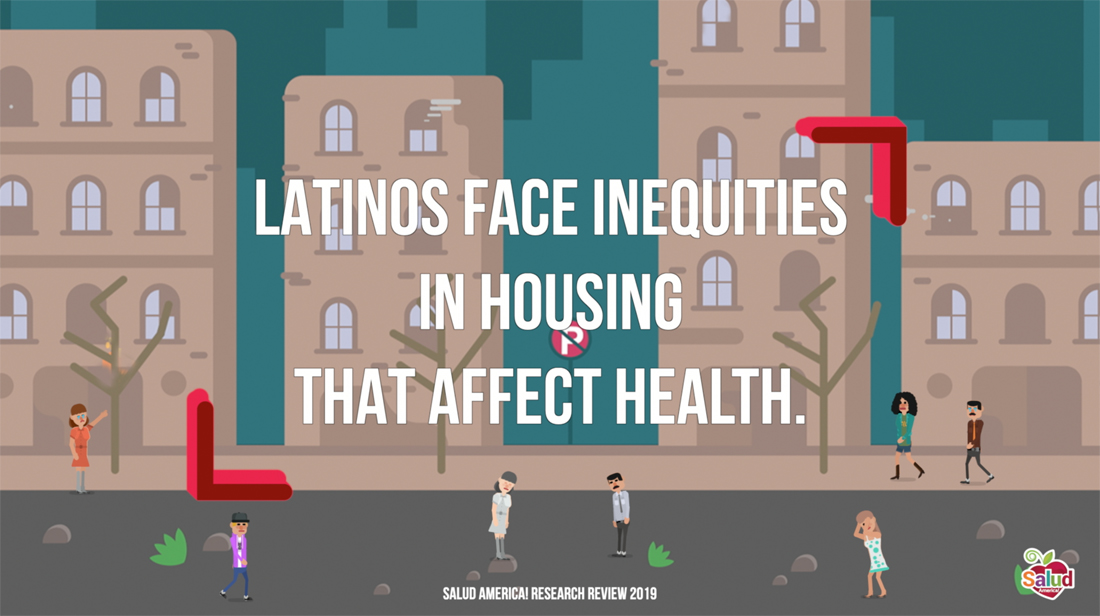 The availability of high-quality, safe, and affordable housing affects health on many levels. Physical conditions within the home, such as the presence of lead, particulates in the air, and allergens, can shape health outcomes for adults and children, whereas policies in multi-residence structures, such as those regarding indoor smoking, noise, and violence can harm or improve residents’ health [5, 18].
The availability of high-quality, safe, and affordable housing affects health on many levels. Physical conditions within the home, such as the presence of lead, particulates in the air, and allergens, can shape health outcomes for adults and children, whereas policies in multi-residence structures, such as those regarding indoor smoking, noise, and violence can harm or improve residents’ health [5, 18].
The neighborhood conditions surrounding the home determine access to health-related resources including healthy foods, recreational spaces, medical resources, and educational or employment opportunities. Where one lives also determines one’s sense of physical safety as it relates to crime in the [6, 19]. Finally, housing affordability and stability affect financial stability, stress, and the overall ability of families to make healthy decisions.
A 2018 study found that housing instability was linked to poor health outcomes in both children and their caregivers [20]. In this study of urban renter families, being behind on rent at any time in the past 12 months, moving more than twice in the past 12 months, or having any history of homelessness was defined as “housing insecurity.” Compared with children in stable housing, children with any form of housing insecurity were more likely to have been in the hospital or have fair and/or poor health at any point in their life. Caregivers who face housing insecurity were more likely to have fair and/or poor health, or maternal depressive symptoms [20].
Importantly, these families were also at high risk for material hardship, including food insecurity, child food insecurity, energy (utility) insecurity, household foregone care, child foregone care, and health cost sacrifices [20].
Therefore, access to high quality, safe, and affordable housing is an important community feature that shapes health outcomes [5].
The Burden of Housing Costs
Housing costs are usually the single largest expense for most households, and are a fundamental driver of where people live [12]. Housing and transportation combined account for approximately half of the average U.S. household budget [21], more so among Latinos [22].
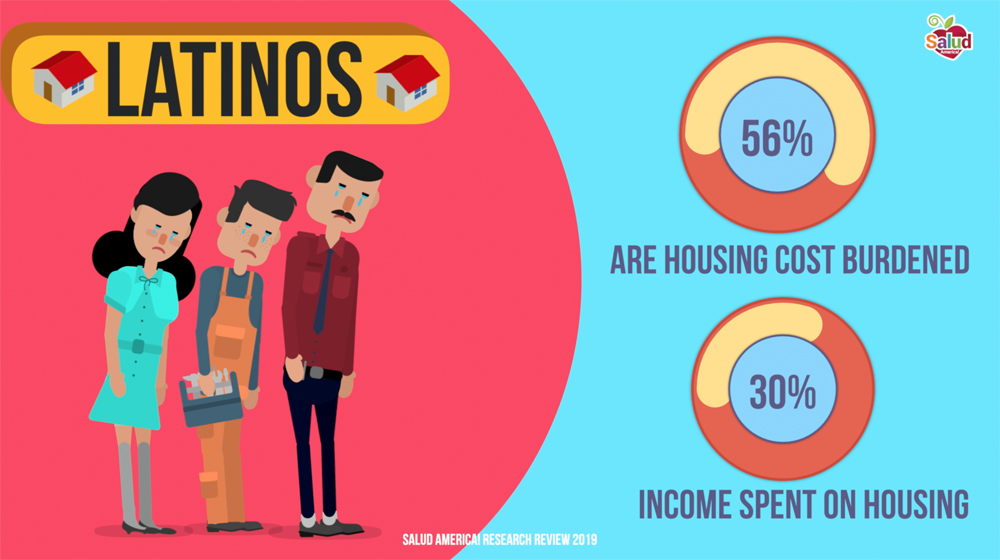 Affordable housing is defined as that which costs no more than 30% of a household’s gross annual income [23]. However, this measure does not include the transportation costs associated with the home’s location. Thus true affordability is related to the cost not only of housing but also to the cost of transportation from that location to work and other locations important to the individual, such as child care, family, and health care [18].
Affordable housing is defined as that which costs no more than 30% of a household’s gross annual income [23]. However, this measure does not include the transportation costs associated with the home’s location. Thus true affordability is related to the cost not only of housing but also to the cost of transportation from that location to work and other locations important to the individual, such as child care, family, and health care [18].
Several studies have found that Latinos in the United States have become increasingly home cost burdened. The amount of Latinos who are “housing cost burdened”─those who spend more than 30 percent of household income on housing costs─has risen from 42.4 percent in 2000 to 56.9% in 2015, according to data from the National Equity Atlas. Latinos are more burdened by housing costs than Whites (46.8%) and every other racial/ethnic group except for African Americans (58.3%) [24]. Across counties, every 10% increase in the share of households severely cost burdened is linked to 29,000 more children in poverty, 86,000 more people who are food insecure, and 84,000 more people in fair or poor health, according to the 2019 County Health Rankings [7].
The Issue of Eviction among Latinos
Latinos, especially Latina women and other women of color, face particular risk of eviction and displacement [22, 25–27]. For the past 3 years (2014-2017), Latino homeownership rates have decreased each year [8], suggesting that the proportion of Latino families renting their homes is increasing.
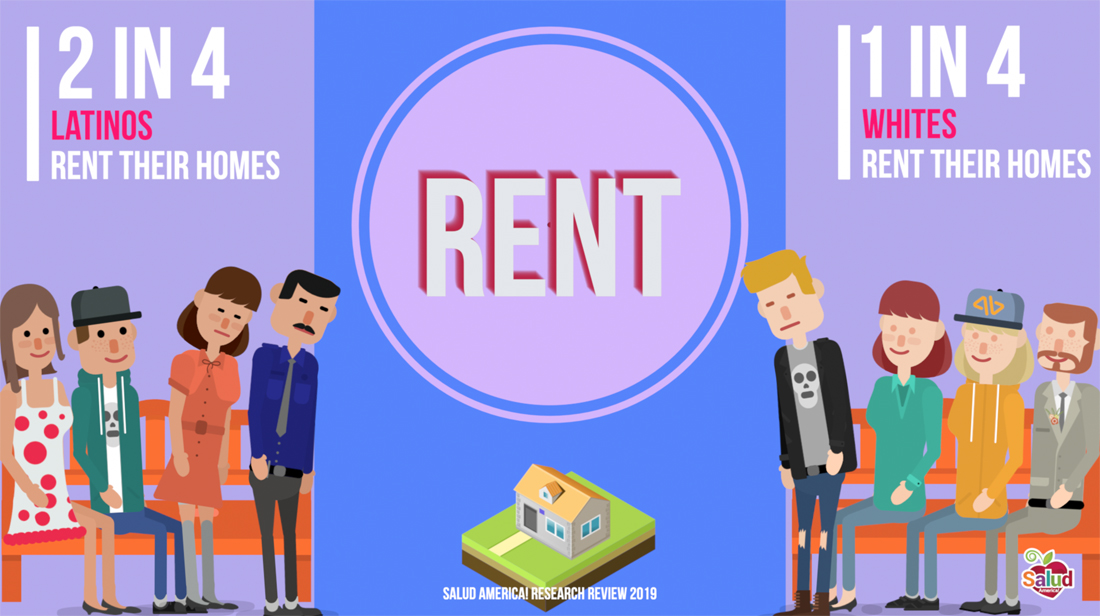 In 2016, 54% of Latino household heads were renting their homes, compared to 28% of White household heads [28], across all levels of educational attainment [8, 28].
In 2016, 54% of Latino household heads were renting their homes, compared to 28% of White household heads [28], across all levels of educational attainment [8, 28].
As the National Association for Latino Community Asset Building (NALCAB) put it in their Guide to Equitable Neighborhood Development:
“These trends present the U.S. economy with a fundamental and long-term challenge: the people who are the demographic future of our nation are not well positioned to lead our economy. Failure to effectively build wealth and create access to opportunity for large segments of our population will become an increasingly critical macroeconomic risk for the country. Housing affordability and equitable neighborhood development are at the crux of this challenge” [12].
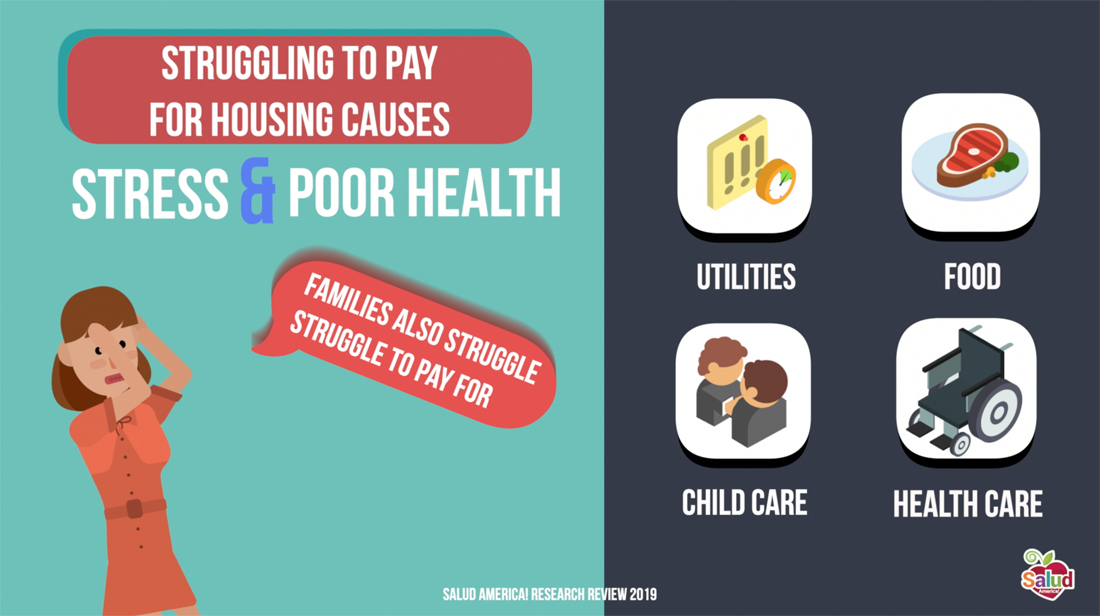 A recent study of home instability in low-income communities found that due to rising housing and utility costs, stagnant or falling incomes among the poor, and a shortfall of federal housing assistance, most poor renting families today devote 50-70% of their income to housing costs, and eviction has become commonplace in low-income communities [22].
A recent study of home instability in low-income communities found that due to rising housing and utility costs, stagnant or falling incomes among the poor, and a shortfall of federal housing assistance, most poor renting families today devote 50-70% of their income to housing costs, and eviction has become commonplace in low-income communities [22].
Latino and African American families, the majority of whom rent their housing, have been disproportionately affected by these trends. In 2013, 25% of Latino renting families spent at least half of their income on housing [22].
Owing to cutbacks in federal budgeting, two thirds of poor renters do not receive any form of federal assistance toward housing, making eviction a real risk for a large proportion of low-income renters [22].
To properly study eviction (both formal and informal) among low-income renters in a multicultural community, the Milwaukee Area Renters Study quantified formal evictions processed through the court, but also informal evictions not processed through court, landlord foreclosures, and building condemnations, with data collected through a novel combination of statistical analyses and survey techniques [22, 25, 26].
Negative Consequences of Eviction, Displacement
The negative consequences of eviction are numerous—first are the obvious effects of involuntary displacement, including disruption of social networks, risk of moving into substandard housing and more dangerous neighborhoods, long commutes, and even homelessness. However, housing instability, and eviction in particular, puts individuals at greater physical and mental health risk [20], leads to employment insecurity [27], and is associated with a prolonged trend of moves and the resultant lack of social/community cohesion [26].
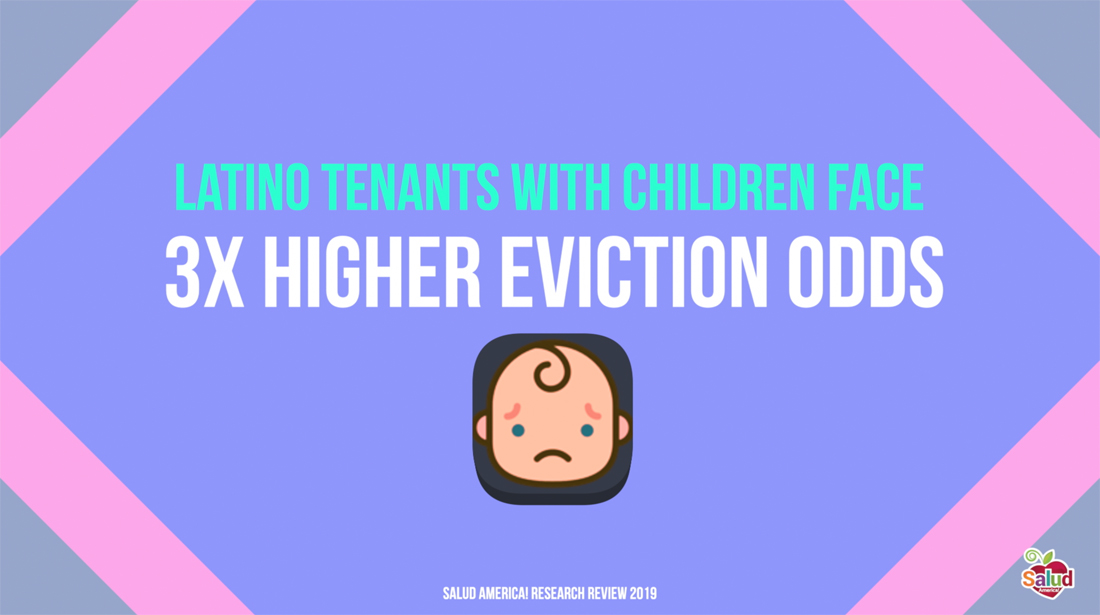 The Milwaukee Area Renters Study found that between 2009 and 2011, the rate of Latino renters being forced to move involuntarily was significantly higher (23%) compared to white (9%) and black (12%) renters, with landlord foreclosure being the primary single cause of eviction [22]. Furthermore, being a woman and having children independently increased one’s risk of eviction.
The Milwaukee Area Renters Study found that between 2009 and 2011, the rate of Latino renters being forced to move involuntarily was significantly higher (23%) compared to white (9%) and black (12%) renters, with landlord foreclosure being the primary single cause of eviction [22]. Furthermore, being a woman and having children independently increased one’s risk of eviction.
One in twelve Latino women reported being evicted in their adult life, compared to one in fifteen white women. Tenants living with children face nearly triple the odds of a formal eviction judgement, even after controlling for amount of debt to the landlord, household income, and several other key factors [22].
Combined, these data suggest that Latino households, particularly those headed by Latinas, are at high risk for eviction and its associated social and health consequences.
Quick links from our Research Review »
More from our Research Review »
- Executive Summary
- Introduction & Methods: Latino Housing, Transportation, and Green Space
- Research: Latino Families Burdened by Housing Costs, Eviction
- Research: Latino Rural Migration Led to Housing, Transportation Inequities
- Research: Latinos Face Big Public Transportation Challenges
- Research: Latino Communities Lack Accessible Green Space
- Strategy: How to Increase Affordable Housing in Latino Communities
- Strategy: How Transit-Oriented Development Benefit Latinos
- Strategy: Improve Public Transit to Improve Latino Quality of Life
- Strategy: Green Space Projects Can Boost Latino Health
- Strategy: Latino Community Involvement Can Spur Environmental Justice
- Policy Implications: Latino Housing, Transportation, and Green Space
- Future Research Needs: Latino Housing, Transportation, and Green Space
References for this section »
1. Krogstad, J. M., & Hispanic, U. S. (2017). Population Growth Has Leveled Off 2017. Pew Research Center.
5. National Academies of Sciences, E. (2017). Communities in Action: Pathways to Health Equity. doi:10.17226/24624
6. Kelleher, K., Reece, J., & Sandel, M. (2018). The Healthy Neighborhood, Healthy Families Initiative. Pediatrics, 142(3), e20180261. doi:10.1542/peds.2018-0261
7. University of Wisconsin Population Health Institute. (n.d.). County Health Rankings Key Findings Report 2019. County Health Rankings & Roadmaps. Retrieved April 30, 2019, from http://www.countyhealthrankings.org/reports/2019-county-health-rankings-key-findings-report
8. Calderon, M. (2017). State of Hispanic Homeownership Report. Hispanic Wealth Project. Retrieved from https://nahrep.org/shhr/
12. National Association for Latino Community Asset Builder (NALCAB). (2018). NALCAB’s Guide to Equitable Neighborhood Development. National Association for Latino Community Asset Builders. Retrieved from https://www.nalcab.org/wp-content/uploads/2018/02/NALCAB_GuideToEquitableNeighborhoodDevelopment_Final.pdf
16. Merck, A. (2018). San Antonio Leaders Weigh Plan to Triple Funding for Affordable Housing. Salud America! Retrieved from https://salud-america.org/san-antonio-leaders-weigh-plan-to-triple-funding-for-affordable-housing/
17. Perkins, H. A. (2010). Green Spaces of Self-Interest Within Shared Urban Governance. Geography Compass, 4(3), 255–268.
18. Joassart-Marcelli, P., Wolch, J., & Salim, Z. (2011). Building the Healthy City: The Role of Nonprofits in Creating Active Urban Parks. Urban Geography, 32(5), 682–711.
19. Frey, W. H. (2010). Census Data: Blacks and Hispanics Take Different Segregation Paths, in State of Metropolitan America. Brookings: Brookings.
20. Sandel, M., Sheward, R., Ettinger de Cuba, S., & Coleman, S. M. (2018). Unstable Housing and Caregiver and Child Health in Renter Families, 144, 2.
21. Currier, E., Key, C., Biernacka-Lievestro, J., Lake, W., Elmi, S., Kypa, S., & Lantz, A. (2018). American Families Face a Growing Rent Burden. Pew Charitable Trusts. Retrieved from https://www.pewtrusts.org/-/media/assets/2018/04/rent-burden_report_v2.pdf
22. Desmond. (2015). Unaffordable America: Poverty, Housing, and Eviction (pp. 1–6). Fast Focus: Institute for Research on Poverty.
23. U.S. Department of Transportation. (2016). Housing and Transportation Affordability. Retrieved from https://www.transportation.gov/mission/health/housing-and-transportation-affordability
24. PolicyLink, & USC Program for Environmental and Regional Equity. (2015). National Equity Atlas: Indicators, Housing Burden, United States. The Atlas | National Equity Atlas. Retrieved April 30, 2019, from https://nationalequityatlas.org/indicators/Housing_burden/By_race~ethnicity%3A49756/United_States/false/Year%28s%29%3A2015/Tenure%3ARenters
25. Desmond, M., & Shollenberger, T. (2015). Forced Displacement from Rental Housing: Prevalence and Neighborhood Consequences. Demography, 52(5), 1751–72.
26. Desmond, M., Gershenson, C., & Kiviat, B. (2015). Forced Relocation and Residential Instability Among Urban Renters. Social Service Review, (89), 227–262.
27. Desmond, M., & Gershenson, C. (2016). Housing and Employment Insecurity Among the Working Poor. Social Problems, 63(1), 46–67.
28. Cilluffo, A., Geiger, A., & Fry, R. (2017). More U.S. households are renting than at any point in 50 years. Pew Research Center: Fact Tank News in the Numbers. Retrieved from https://www.pewresearch.org/fact-tank/2017/07/19/more-u-s-households-are-renting-than-at-any-point-in-50-years/
Explore More:
HousingBy The Numbers
56.9
percent
of Latinos are "housing cost burdened"



